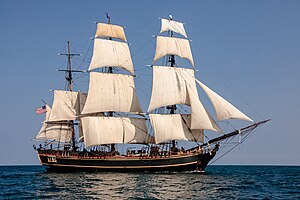HMS Bounty

Replica of Bounty, built in 1960
|
|
| History | |
|---|---|
|
|
|
| Name: | Bethia |
| Owner: | Private merchant service |
| Builder: | Blaydes shipyard, Kingston-upon-Hull, England |
| Launched: | 1784 |
| In service: | 1784–87 |
| Fate: | sold to the Royal Navy, 23 May 1787 |
| History | |
|
|
|
| Name: | Bounty |
| Cost: | purchased for £1,950 |
| Acquired: | 23 May 1787 |
| Commissioned: | 16 August 1787 |
| In service: | 1787–90 |
| Fate: | Burned by mutineers, 23 January 1790 |
| General characteristics | |
| Class and type: | Armed Vessel |
| Tons burthen: | 220 26⁄94 |
| Length: | 90 ft 10 in (27.69 m) |
| Beam: | 24 ft 4 in (7.42 m) |
| Depth of hold: | 11 ft 4 in (3.45 m) |
| Propulsion: | Sails |
| Sail plan: | Full rigged ship |
| Complement: | 44 officers and men |
| Armament: |
|
HMS Bounty, also known as HM Armed Vessel Bounty, was a small merchant vessel purchased by the Royal Navy for a botanical mission. The ship was sent to the Pacific Ocean under the command of William Bligh to acquire breadfruit plants and transport them to British possessions in the West Indies. That mission was never completed due to a mutiny led by Acting Lieutenant Fletcher Christian. This incident is now popularly known as the Mutiny on the Bounty. The ship was later burned on Pitcairn Island by the mutineers. The remains of the Bounty were re-discovered in 1957 by an American adventurer and various parts of it have been salvaged since then.
Bounty was originally known as collier Bethia, built in 1784 at the Blaydes shipyard in Kingston upon Hull, East Yorkshire, England. The vessel was purchased by the Royal Navy for £1,950 on 23 May 1787, refit, and renamed Bounty. The ship was relatively small at 215 tons, but had three masts and was full-rigged. After conversion for the breadfruit expedition, she was equipped with four 4-pounder (1.8 kg) cannon and ten swivel guns.
The ship had been purchased by the Royal Navy for a single mission in support of an experiment: the acquisition of breadfruit plants from Tahiti, and the transportation of those plants to the West Indies in the hope that they would grow well there and become a cheap source of food for slaves. The experiment was proposed by Sir Joseph Banks, who recommended William Bligh as commander, who in turn was promoted through a prize offered by the Royal Society of Arts.
...
Wikipedia
